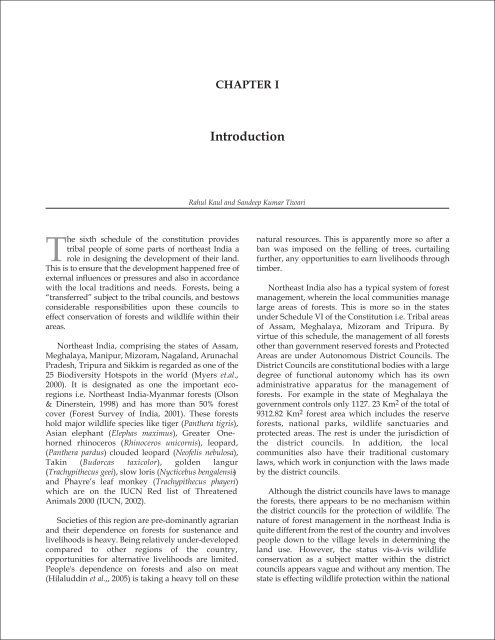Bringing Back Manas
Bringing Back Manas
Bringing Back Manas
- TAGS
- bringing
- manas
- www.ifaw.org
You also want an ePaper? Increase the reach of your titles
YUMPU automatically turns print PDFs into web optimized ePapers that Google loves.
The sixth schedule of the constitution provides<br />
tribal people of some parts of northeast India a<br />
role in designing the development of their land.<br />
This is to ensure that the development happened free of<br />
external influences or pressures and also in accordance<br />
with the local traditions and needs. Forests, being a<br />
“transferred” subject to the tribal councils, and bestows<br />
considerable responsibilities upon these councils to<br />
effect conservation of forests and wildlife within their<br />
areas.<br />
Northeast India, comprising the states of Assam,<br />
Meghalaya, Manipur, Mizoram, Nagaland, Arunachal<br />
Pradesh, Tripura and Sikkim is regarded as one of the<br />
25 Biodiversity Hotspots in the world (Myers et.al.,<br />
2000). It is designated as one the important ecoregions<br />
i.e. Northeast India-Myanmar forests (Olson<br />
& Dinerstein, 1998) and has more than 50% forest<br />
cover (Forest Survey of India, 2001). These forests<br />
hold major wildlife species like tiger (Panthera tigris),<br />
Asian elephant (Elephas maximus), Greater Onehorned<br />
rhinoceros (Rhinoceros unicornis), leopard,<br />
(Panthera pardus) clouded leopard (Neofelis nebulosa),<br />
Takin (Budorcas taxicolor), golden langur<br />
(Trachypithecus geei), slow loris (Nycticebus bengalensis)<br />
and Phayre’s leaf monkey (Trachypithecus phayeri)<br />
which are on the IUCN Red list of Threatened<br />
Animals 2000 (IUCN, 2002).<br />
Societies of this region are pre-dominantly agrarian<br />
and their dependence on forests for sustenance and<br />
livelihoods is heavy. Being relatively under-developed<br />
compared to other regions of the country,<br />
opportunities for alternative livelihoods are limited.<br />
People's dependence on forests and also on meat<br />
(Hilaluddin et al.,, 2005) is taking a heavy toll on these<br />
CHAPTER I<br />
Introduction<br />
Rahul Kaul and Sandeep Kumar Tiwari<br />
natural resources. This is apparently more so after a<br />
ban was imposed on the felling of trees, curtailing<br />
further, any opportunities to earn livelihoods through<br />
timber.<br />
Northeast India also has a typical system of forest<br />
management, wherein the local communities manage<br />
large areas of forests. This is more so in the states<br />
under Schedule VI of the Constitution i.e. Tribal areas<br />
of Assam, Meghalaya, Mizoram and Tripura. By<br />
virtue of this schedule, the management of all forests<br />
other than government reserved forests and Protected<br />
Areas are under Autonomous District Councils. The<br />
District Councils are constitutional bodies with a large<br />
degree of functional autonomy which has its own<br />
administrative apparatus for the management of<br />
forests. For example in the state of Meghalaya the<br />
government controls only 1127. 23 Km 2 of the total of<br />
9312.82 Km 2 forest area which includes the reserve<br />
forests, national parks, wildlife sanctuaries and<br />
protected areas. The rest is under the jurisdiction of<br />
the district councils. In addition, the local<br />
communities also have their traditional customary<br />
laws, which work in conjunction with the laws made<br />
by the district councils.<br />
Although the district councils have laws to manage<br />
the forests, there appears to be no mechanism within<br />
the district councils for the protection of wildlife. The<br />
nature of forest management in the northeast India is<br />
quite different from the rest of the country and involves<br />
people down to the village levels in determining the<br />
land use. However, the status vis-à-vis wildlife<br />
conservation as a subject matter within the district<br />
councils appears vague and without any mention. The<br />
state is effecting wildlife protection within the national

















